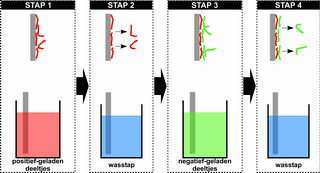DNA layer reduces risk of reserve parts being rejected

Dutch researchers Jeroen van den Beucken and John Jansen have given body implants a DNA layer. This layer ensures a better attachment, more rapid recovery of the surrounding tissue and less immune responses. The older we get the more 'reserve-parts' we need. Up until now placing such parts yielded advantages, but also disadvantages such as inflammations and immune responses. Van den Beucken's invention makes it easier and more reliable to use implants and has already been patented.
Van den Beucken reasoned that a DNA coating should have a lot of advantages. Such a coating approximates the body's own material with the result that a less intense immune response occurs. Further DNA is rich in phosphate groups that can speed up the attachment to bone tissue and therefore the integration of bone implants in the native bone tissue. Finally, DNA can be enriched with biologically active factors that, for example, facilitate the formation of bone tissue and blood vessels. All in all, a DNA coating could be safe, reduce the immune response, facilitate bone attachment and be functionalisable.
However, enzymes in the body will quickly break down a DNA coating. A method therefore had to be found to firmly attach the DNA to the implant surface. Van den Beucken used the Layer-by-Layer deposition technique (see Figure 1) to produce a multilayer coating. This coating was tested in cell cultures and animal experiments for its safety, immune response, bone attachment and functionalisation. The DNA layer was also found to speed up the deposition of calcium phosphate and could, for example, be adapted to promote bone and blood vessel formation. The good research results led to the patenting of DNA coatings for implants. A biomedical company is currently investigating whether they can take over the patent.
Following this successful result, Van den Beucken will investigate whether DNA layers can be used for the application of DNA membranes to prevent post-operative adhesions, and in biosensors such as an implanted glucose sensor for diabetic patients.
Source: NWO




















